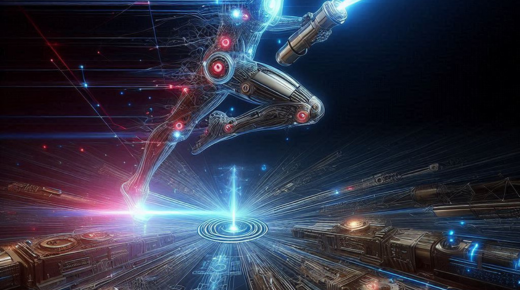What Is AI Artificial intelligence in the gaming environment pertains to an algorithm of rules and schemes, which make game characters seemingly perform intelligent processes to simulate both friends and antagonists, for that matter-the AI is for characters, entities, and various components of any given game for improving the general look and realistic character response upon every action within it.
How does AI make video games more enjoyable? AI makes games more engaging through the control of NPCs, dynamic challenges, adaptive difficulty, and assistance in the building of believable virtual worlds. It can give the game smarter enemies, more interactive allies, and seamless, interactive environments.
What are some types of AI most commonly used in video games? Common types of AI include:
Pathfinding AI: This type of AI decides how characters should navigate their environments.
Behavior Trees: To manage complex NPC behavior and decision-making.
Finite State Machines (FSMs): For modeling simple NPC states like idle, patrol, and attack.
Machine Learning: For adaptation in gameplay, especially in open-world or strategy games.
Pathfinding AI is algorithms that enable characters or entities to find a path from one point to another in a game world. Probably the most common algorithm in use nowadays is an A* (A-star) algorithm, which calculates the shortest or most efficient route and can steer clear of many obstacles.
What is AI in video game NPCs? A game character who is a Non-Player Character (NPC) uses AI to make choices, react to player actions, and simulate realistic behavior. An example would be a role-playing game (RPG), which can have the NPC schedules, emotions, or even dialogue trees reacting to players.
How does AI in video games adapt to player behavior? AI can adapt to player behavior by analyzing their actions and changing the game environment accordingly. This might include adjusting enemy difficulty, providing different story paths, or even altering NPC responses based on player choices.
What is the role of AI in enemy behavior in video games? AI controls enemy behavior, such as patrolling, chasing, hiding, attacking, and coordinating in groups. It can also make enemies adapt to player tactics, creating more challenging and varied encounters. For example, enemies may learn to anticipate player actions or react to previous strategies.
What is the difference between scripted AI and reactive AI?
Scripted AI follows predefined patterns or sequences, as is often seen in fixed enemy behaviors or events.
Reactive AI responds dynamically to the player’s actions or game state, adapting in real-time to make the gameplay more unpredictable.
This includes a system that can predict the weather pattern, day and night cycles, and ecosystems; these are quite complex systems which improve the reality of the video game world. AI can make NPCs behave naturally, such as the interaction of different NPCs.
It is referred to as procedural generation, which utilizes algorithms for dynamic creation of game content, such as maps, levels, or even stories. AI-powered procedural generation can adapt the content based on player actions or preferences, ensuring each play experience is unique yet does not comprise gameplay balance.
How does AI help in open-world gameplay? AI helps create a dynamic and living environment in open-world games. AI governs NPC schedules, wildlife behaviors, and environmental events, which gives the world an impression of constant evolution, even when players aren’t directly interacting with every element of the world.
How does AI handle combat in video games? In combat, AI dictates enemy actions, such as attack patterns, defense, and movement. More advanced AI may learn from player tactics or even simulate squad tactics, with enemies flanking or cooperating in groups. For example, enemies in games like Halo or The Last of Us coordinate with one another based on their environment.
Machine learning in video games’ AI- This involves AI systems that can “learn” from data, often by observing player behaviors or game results. With this, the AI can improve and learn over time. In games, for example, it may indicate that NPCs learn from how a player plays, creating a different challenge each time.
Yes, AI can be used to create personalized gaming experiences. It is possible to tailor challenges, quests, and even storylines according to the player’s actions or preferences using AI. For example, in games like The Elder Scrolls V: Skyrim, AI-driven systems adjust NPC responses or offer quests based on player behavior.
AI-driven dialogue systems in video games: An AI-driven dialogue system, similar to the one in RPGs, can be utilized by NPCs for dynamic, context-based conversations with the player. It may modify responses according to a player’s actions, previous interactions, or the state of the game world to enhance the overall experience of the narrative.
Dynamic difficulty adjustment (DDA) is an AI technique that automatically adjusts the difficulty of a game based on the player’s performance. For example, if a player is not doing well, the AI may make enemies easier or provide more help, but if the player is doing well, the game may increase the challenge.
A Finite State Machine (FSM) is the system for controlling NPC behaviors through different “states” – such as idle, alert, or attacking. AI switches between states based on such conditions as player proximity or other game variables. This will cause the NPCs to behave more realistically and with better variety.
How does AI control NPC companions in video games? AI controls NPC companions by dictating their behavior in combat, puzzle-solving, and interactions with the player. Advanced AI systems can make companions react to changing combat conditions, provide tactical support, or even adapt their behavior based on the player’s actions, as seen in games like The Last of Us or Mass Effect.
How is AI applied to stealth mechanics in games? AI is really the key for the responsive enemies of stealth games. They are the ones who track, detect, and search for the player. In a game like Metal Gear Solid or Assassin’s Creed, enemies will patrol areas, follow sound cues, and investigate suspicious activities that add more thrill and challenge to stealth tactics.
What is the role of AI in creating puzzles in video games? AI can help generate puzzles dynamically or control the logic behind puzzle-solving. In some cases, it can adjust the difficulty based on the player’s progress or create new puzzle variations to keep the gameplay engaging. AI-driven puzzle systems are often used in roguelikes or puzzle games.
How do AI enemies coordinate in a group? AI can allow enemies to work together by coordinating actions such as flanking, covering each other, or setting traps. This kind of group AI makes encounters more challenging and dynamic, as seen in team-based shooters like Rainbow Six Siege or Left 4 Dead.
Can AI make decisions based on emotions in video games? Yes, AI can simulate emotions to make NPCs behave more realistically. In some advanced games, NPCs react emotionally to the player’s actions or dialogue choices, such as becoming friendly, hostile, or fearful. Games like The Sims or Detroit: Become Human feature AI-driven emotional responses.
What is AI’s role in story-driven video games? AI can drive narrative progression by controlling NPC reactions, determining which story branches open up based on player decisions, and even creating dialogue choices. Advanced AI systems help adapt the story and character interactions, making the narrative feel more personal and reactive to the player’s choices.
How does AI impact the pacing of a video game? AI can affect pacing by adjusting difficulty, introducing new challenges at appropriate moments, and providing strategic gameplay shifts. In action games, for example, AI might send more enemies when the player is doing well or provide a break in the action to allow for exploration and story development.
What is the connection between AI and procedural generation in games? AI and procedural generation often go hand in hand in order to generate varied, responsive, and unique game experiences. For instance, in roguelike games, procedural generation produces levels, and AI governs how enemies act in those levels, so that no two playthroughs will be the same.
What’s the future of AI in video games? The future of AI in video games is full of promise for:
More realistic NPCs: With improved AI, NPCs could have deeper personalities and more complex reactions to the player’s actions.
Better procedural storytelling: AI could create dynamic, adaptive narratives tailored to individual players.
Advanced machine learning: AI could learn directly from players, making enemies smarter and more responsive to gameplay tactics.
Adaptive AI is a type of system in video games where the behavior is changed according to the actions of a player and his abilities. If a player becomes too skilled or defeats the same type of enemy repeatedly, adaptive AI may make adjustments so that the gameplay is balanced again.
In sandbox games, AI determines how it reacts to player-driven events. The AI in Minecraft or Garry’s Mod dictates the actions of non-player entities, wildlife, and other objects that players interact with to simulate the world’s response to player-driven events. It may create spontaneous events or lead the player through the world, with creative freedom being allowed.
Can AI enhance player engagement in a video game? Absolutely. AI can engross the interest of the players by providing experience in personalized steps or granting the difficulty level adjustments and even strengthening NPC interactivity. AI can present dynamic gameplay worlds and therefore keeps the players interested.
Can there be challenges in developing video game AI? Challenges in AI in games are:
Balancing difficulty: Ensuring AI doesn’t feel either too easy or too hard.
Avoiding predictability: Making sure AI doesn’t behave in repetitive or predictable ways.
Optimizing performance: AI systems can be resource-intensive, especially in open-world or large-scale games.
Conclusion
It’s safe to say that AI has really developed greatly in video games, from augmenting the gameplay experience of a player, governing the dynamics of gameplay, to creating worlds which are almost immersed. Adaptive difficulty, complex enemy behavior, or whatever is ahead in terms of the development of AI is to be critical components in the gaming world. More so, in terms of expanding possibilities through the advancements in machine learning and procedural generation, more dynamic and personalized experiences await players in future games.




